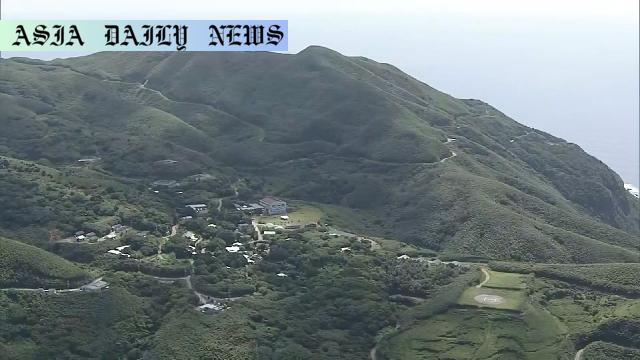Earthquakes in the Tokara island chain have surged, with over 1,700 tremors recorded since June 21, the highest on record.
Seismic activity surges on Tokara island chain with over 1,700 tremors recorded.
Largest quake reached an intensity of lower 6 on the Japanese scale.
Japan Meteorological Agency warns of continued strong quakes.

Record-breaking seismic activity in Japan’s Tokara island chain
In an unsettling and unprecedented development, the Tokara island chain in Kagoshima Prefecture, southwestern Japan, has experienced an extraordinary increase in seismic activity. Over 1,700 tremors have been recorded since June 21, many of which were strong enough to be felt by residents. This recent spike in earthquake activity, centered around the islands of Akusekijima and Kodakarajima, has exceeded all previous seismic records for the region.
Among the recorded quakes, Akusekijima has been hardest hit, including one earthquake with an intensity of lower 6 on the Japanese seismic scale that ranges from zero to seven. Local residents are on high alert as this marks the most powerful tremor in the recent series. On Sunday, the area registered two upper-5 intensity quakes, followed by a substantial magnitude 5.1 earthquake with lower-5 intensity on Monday. Seismic records from the Japan Meteorological Agency (JMA) indicate an official count of 1,713 tremors as of 4 a.m. Wednesday, with sustained daily activity—60 quakes on Monday and 39 on Tuesday alone.
A history of seismic instability in the region
The Tokara island chain is no stranger to seismic movements. Similar quake sequences occurred in 2021 and earlier in 2023, but the current wave of seismic activity is by far the most intense. Experts believe that the geological complexities underlying the region make it particularly prone to frequent tremors. The Akusekijima and Kodakarajima islands lie near tectonic plate boundaries, making the region a hotspot for tectonic stress release.
While some quakes have caused minimal structural damage to local infrastructure, the frequency at which these tremors are occurring is a cause for scientific and civic scrutiny. Geologists are closely monitoring the area to forecast future seismic behavior, as sustaining such high levels of activity can have cascading effects on neighboring islands and even nearby mainland areas.
Japan Meteorological Agency’s warnings
Amidst the intensifying quakes, the Japan Meteorological Agency (JMA) has issued warnings of potential larger earthquakes with intensities of up to lower 6. Residents have been advised to remain vigilant and prepare emergency kits for evacuation. The JMA continues to analyze data from this seismic outburst to better understand its origins and potential ramifications.
The agency has stressed that while such seismic swarms are not uncommon in volcanic regions, the persistent frequency of these quakes necessitates precautionary measures. Officials are urging the inhabitants of Akusekijima and nearby areas to avoid unnecessary travel and secure their homes to minimize the risk of injury or loss during future quakes.
Broader implications of seismic activity
This surge in seismic activity is not localized to the Tokara chain alone. It highlights the broader geological volatility of Japan, a country that rests on the Pacific “Ring of Fire,” where tectonic activity is frequent. Scientists worldwide are closely observing the evolving patterns of these tremors, as they could reveal emerging trends or risks that extend beyond Japan’s borders.
With Japan being one of the most seismically active countries, its preparedness and management systems for such natural events often serve as a reference model for disaster-prone regions globally. The series of quakes is also a reminder of the continuous need to innovate and strengthen earthquake prediction technologies, public education programs, and disaster response mechanisms in vulnerable regions.
What’s ahead?
Although the JMA has cautioned against immediate higher-magnitude quakes, the ongoing tremors have raised fears about the possibility of a larger seismic event. Geological experts have been swift in mobilizing resources to study this phenomenon, while local authorities are doubling down on ensuring public safety. It remains unclear how long this intense seismic sequence will last, but one thing is certain: the people of Akusekijima, Kodakarajima, and surrounding regions are bracing for turbulent days ahead.
Commentary
Reflecting on the impact of seismic surges in Japan
The news of over 1,700 earthquakes striking the Tokara island chain offers a stark reminder of nature’s unpredictable power. Japan, a nation synonymous with resilience in the face of natural disasters, is yet again witnessing a seismic phenomenon that emphasizes the thin line between normalcy and emergency in geologically active zones.
Preparedness amidst uncertainty
What sets Japan apart is its advanced preparation to deal with such events. From early warning systems to detailed public safety measures, Japan remains a global leader in mitigating the risks of natural disasters. Still, the sheer frequency and intensity of the earthquakes in this case can overwhelm even the most robust preparedness strategies. The JMA’s notice urging residents to prepare for more high-intensity tremors underscores the uncertainty of living in the shadow of geological fury.
The wider lessons of seismic activity
The persistent tremors in Tokara are not just a story for Japan but a global learning moment. They demonstrate the importance of community resilience, scientific vigilance, and governmental support in disaster response. Moreover, they shine a spotlight on how swiftly nature can alter landscapes and disrupt daily life. The world must continue to invest in scientific research and technologies that lessen the impacts of similar occurrences elsewhere.
The human response to natural unpredictability
At its core, this story is about the spirit of survival amidst uncertainty. While tectonic movements that date back millions of years shape such events, it is the human capacity for adaptation and innovation that defines how societies navigate these challenges. In the face of ongoing threats, we see the enduring power of preparation and the unyielding determination of affected communities to adapt, rebuild, and persevere.


